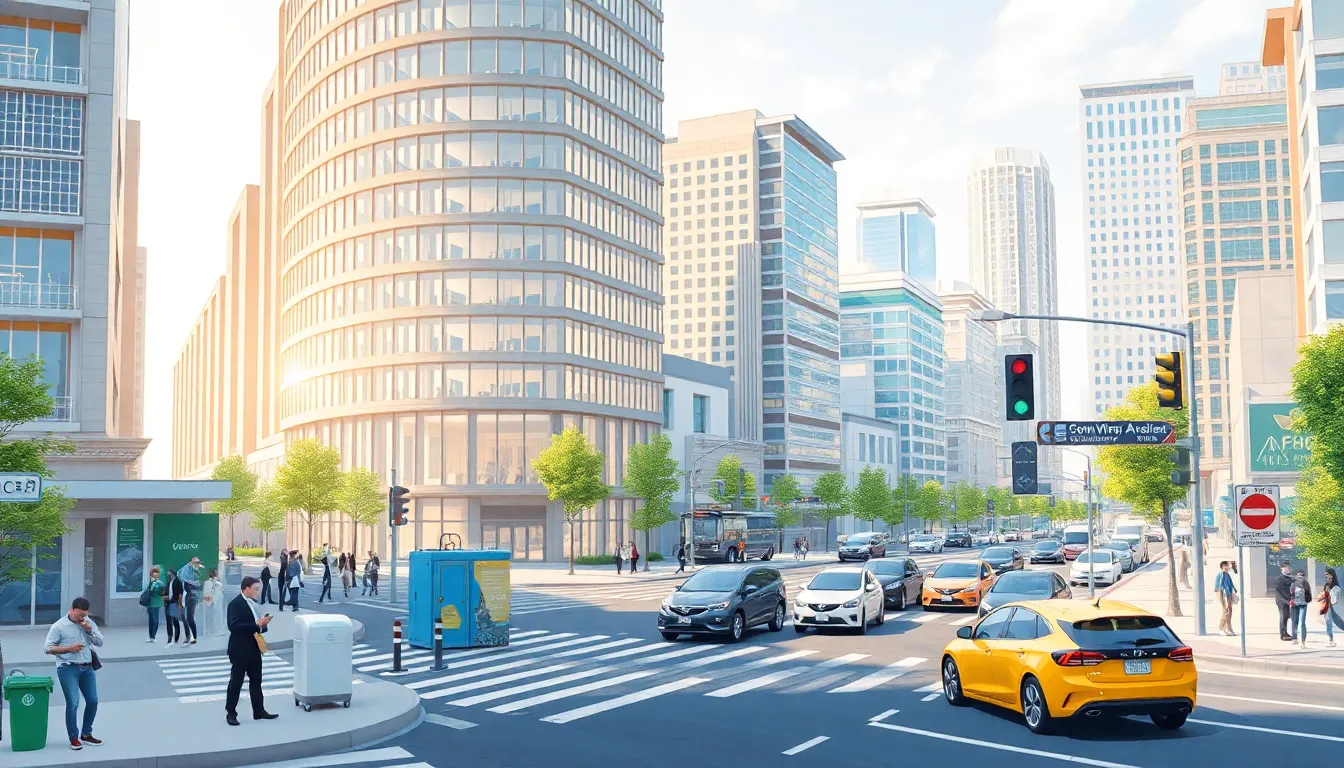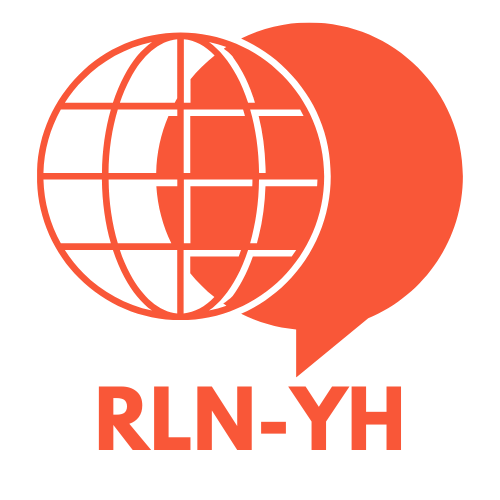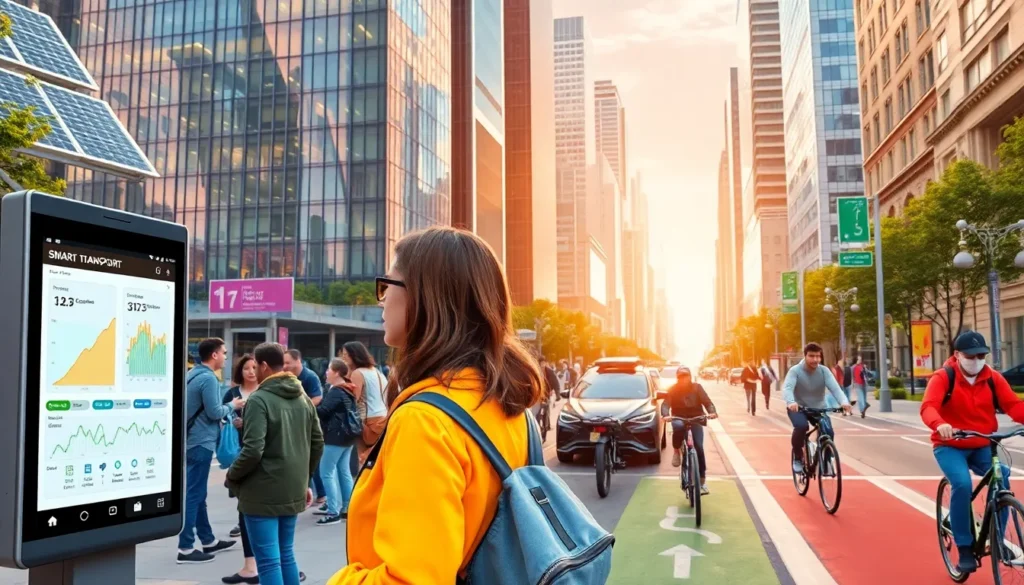Table of Contents
ToggleImagine a city where traffic lights know your favorite playlist, trash cans remind you when they’re full, and streetlights adjust their brightness based on how many people are around. Welcome to the world of smart cities powered by the Internet of Things (IoT). This isn’t just sci-fi fantasy; it’s the future knocking on our doors, and it’s ready to make urban living more convenient, efficient, and yes, even a bit more fun.
As cities grow and challenges multiply, IoT technology swoops in like a superhero. It connects devices and systems, turning everyday urban life into a seamless experience. From smart parking solutions that save time to energy-efficient buildings that reduce costs, the possibilities are endless. Get ready to dive into how IoT is transforming our cities into smarter, more sustainable places to live, work, and play.
Overview Of Internet Of Things For Smart Cities
Internet of Things (IoT) significantly enhances smart cities by interconnecting devices, systems, and infrastructure. This technology facilitates real-time data collection and analysis, which aids in informed decision-making for urban management. Smart traffic systems exemplify how IoT minimizes congestion by optimizing traffic flow in real-time.
Energy consumption also improves through IoT-enabled smart lighting that adjusts based on occupancy and natural light levels. Public safety benefits from connected surveillance systems that enhance monitoring capabilities and response times. Moreover, environmental monitoring solutions track air quality and noise levels, ensuring a healthier urban environment.
Smart parking applications streamline vehicle management, helping residents locate available spaces effortlessly. Water management systems utilize IoT to detect leaks, reducing wastage and enhancing sustainability. Data collected from these systems supports city planners in developing targeted improvements and infrastructure upgrades.
IoT fosters community engagement, allowing residents to interact more effectively with municipal services via mobile applications. Applications enable reporting of issues, such as potholes or streetlight outages, promoting civic participation.
These interconnected solutions contribute to a cohesive urban ecosystem where resource efficiency and quality of life elevate. Development of smart cities relies on tactical integration of IoT to resolve pressing urban issues, ultimately resulting in smarter, more sustainable cities.
Key Components Of Smart Cities

Smart cities rely on advanced technologies to streamline urban operations, improve residents’ quality of life, and promote sustainable growth. Key components include smart infrastructure and effective connectivity solutions.
Smart Infrastructure
Smart infrastructure consists of modernized facilities and systems that utilize IoT technologies. Intelligent transportation systems enhance mobility by providing real-time traffic updates, optimizing routes, and easing congestion. Sustainable energy solutions leverage solar and wind resources while ensuring efficient distribution. Additionally, smart waste management systems monitor bin levels, optimize collection routes, and reduce operational costs. Effective water management infrastructure detects leaks and monitors consumption, promoting conservation efforts. Each element works synergistically to create a responsive urban environment.
Connectivity Solutions
Connectivity solutions serve as the backbone of smart cities, enabling seamless communication between devices. High-speed internet access, including 5G networks, facilitates instantaneous data transmission. LoRaWAN technology establishes long-range communication for IoT devices, supporting a range of applications from environmental monitoring to asset tracking. Furthermore, public Wi-Fi networks enhance civic engagement by connecting residents to city services and information. Comprehensive data integration platforms combine insights from various sources, allowing city officials to make informed decisions and respond effectively to urban challenges.
Benefits Of Implementing IoT In Smart Cities
Implementing IoT in smart cities delivers numerous advantages that enhance urban living.
Enhanced Efficiency
Enhanced efficiency emerges from real-time data analytics. Traffic management systems respond instantly, reducing congestion and travel time. Smart lighting adjusts based on occupancy, conserving energy without sacrificing safety. Waste management becomes streamlined, as IoT sensors determine fill levels in bins, optimizing collection routes. Energy consumption in buildings decreases through smart HVAC systems that regulate temperatures based on occupancy. These initiatives save cities money while improving the flow of everyday activities.
Improved Sustainability
Improved sustainability is another significant benefit derived from IoT technologies. Environmental monitoring systems provide vital data on air quality, allowing cities to address pollution sources effectively. IoT-enabled irrigation systems use moisture sensors to optimize water usage in public parks and green areas. Renewable energy resources integrate seamlessly through smart grids, promoting energy independence and reduced carbon footprints. Recycling initiatives gain momentum with smart waste bins that educate residents about proper disposal methods. Collectively, these efforts contribute to healthier living environments and a greener future for urban populations.
Challenges And Considerations
Implementing IoT in smart cities involves various challenges and considerations. Addressing these is crucial for successful integration and sustainability.
Data Privacy Concerns
Data privacy remains a significant challenge in smart cities. Numerous connected devices collect vast amounts of personal information from residents. Unauthorized access to this data poses risks, threatening user confidentiality. Strong cybersecurity measures are essential to safeguard sensitive information. Establishing transparent data usage policies fosters trust among citizens. Regulations like the General Data Protection Regulation (GDPR) help ensure data protection. Cities must prioritize user consent in data collection processes to enhance privacy.
Infrastructure Costs
Infrastructure costs present another critical consideration for smart city initiatives. Implementing advanced technologies requires substantial investment in physical and digital infrastructure. Budget constraints often limit resource availability for upgrades. Maintenance of IoT systems adds ongoing expenses, impacting city finances. Collaborating with public-private partnerships can alleviate some financial burdens. Funding from government grants and technology firms supports infrastructure development. Prioritizing cost-effective solutions ensures sustainable growth in smart city projects.
Future Trends In IoT For Smart Cities
Emerging technologies will shape the future of IoT in smart cities. Artificial intelligence integration enhances data analysis, allowing municipalities to make informed decisions quickly. These advancements lead to more responsive urban environments that adapt to changing conditions and community needs.
5G connectivity represents a significant leap for smart city applications. With its high speed and low latency, real-time data exchange between devices becomes seamless. Smart traffic management systems can operate more efficiently, reducing congestion and improving overall mobility.
Sustainability initiatives will gain momentum through IoT innovations. Smart waste management solutions leverage sensors to optimize collection routes, minimizing fuel usage and emissions. Environmental monitoring tools will provide critical insights, driving community efforts toward cleaner air and reduced noise levels.
Public safety technologies will evolve alongside IoT capabilities. Advanced surveillance systems will use AI to analyze video feeds, enhancing security responses and deterrences. Residents will benefit from proactive measures, creating safer urban spaces.
Urban mobility options will diversify, influenced by IoT advancements. Smart public transit systems can provide real-time updates, improving rider experience and encouraging usage. Electric and autonomous vehicles will become more integrated, promoting efficient transportation networks.
Citizen engagement will strengthen through IoT platforms that facilitate communication between residents and local governments. Mobile applications enable effortless feedback on municipal services, fostering a sense of community participation. Innovative platforms will bridge the gap, ensuring that urban development aligns with citizen expectations.
Digital twins of urban environments will emerge, utilizing real-time data for planning and development. These virtual models allow city planners to test scenarios, enhancing strategic decision-making. Ultimately, simulations will lead to more resilient infrastructure and better resource management.
Overall, trends in IoT for smart cities signify a transformative era for urban living. With evolving technologies at the forefront, cities become smarter, more sustainable, and increasingly attuned to the needs of their inhabitants.
The integration of the Internet of Things into urban environments is paving the way for smarter cities that prioritize efficiency and sustainability. By leveraging real-time data and advanced technologies, cities can enhance public services, improve safety, and foster community engagement.
As urban populations continue to grow, the need for innovative solutions becomes increasingly vital. Addressing challenges like data privacy and infrastructure costs will be crucial for successful implementation.
With emerging technologies on the horizon, the future of smart cities looks promising. Enhanced connectivity and intelligent systems will not only streamline urban living but also create healthier and more sustainable environments for all residents. The journey toward smarter cities is just beginning, and its potential is vast.





